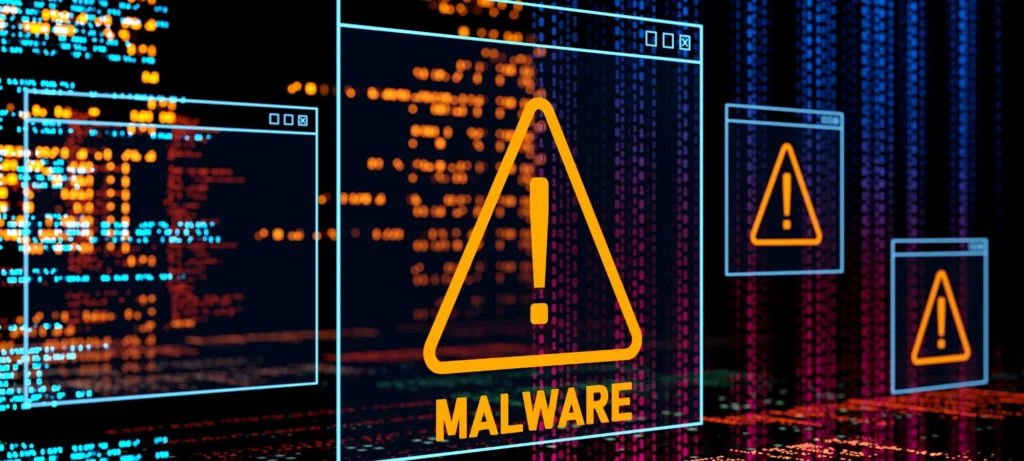Ransomware attacks have become one of the most significant threats to modern businesses, targeting everything from critical systems and cloud services to personal user accounts and legacy systems.
These sophisticated attacks use malicious software designed to encrypt files, effectively locking users out of their systems until they pay the ransom—often in untraceable cryptocurrency.
The ransomware risk has evolved beyond isolated disruptions; it now threatens the continuity and credibility of entire organizations.
What Is Ransomware?
Ransomware is malicious software that encrypts files, making them unusable until victims pay a decryption fee.
At its core, ransomware is extortion that disrupts operations, compromises data, and damages security posture.
Moreover, it uses malicious code to infiltrate systems, spread across networks, and lock access to essential files and applications. Attackers frequently use techniques focused on exploiting vulnerabilities in both software and network security to facilitate infections.
The evolution of ransomware has been driven by both technical sophistication and attacker creativity. These threats can now evade traditional antivirus software, exploit security settings, and disguise themselves in regular system activity.
Ransomware often gains access by exploiting security vulnerabilities in software and network defenses. Attackers often demand decryption keys as ransom, but there is no guarantee that paying will result in receiving valid decryption keys to restore access to encrypted files.
It’s no longer enough to simply avoid malicious links or scan for known threats. Prevention requires comprehensive ransomware prevention strategies that span from technical defenses to user training and strategic incident response preparation.

How Ransomware Spreads: Key Infection Vectors
To effectively prevent ransomware attacks, organizations need to understand how ransomware spreads across networks and devices.
Ransomware operators exploit a wide range of infection vectors, often using layered techniques to bypass defenses and reach critical systems. Recognizing these methods is essential to reducing the attack surface and improving ransomware protection.
Understanding the various vectors is a foundational element in any ransomware prevention strategy—and a necessary step toward closing security gaps before they are exploited.
Recognizing the Signs of a Ransomware Attack
Early detection is one of the most important aspects of ransomware protection. The sooner your team identifies suspicious behavior, the more likely you can contain the damage, isolate infected systems, and prevent ransomware from spreading across critical infrastructure.
Telltale signs include:
- Unexplained or unauthorized login attempts from unfamiliar IP addresses.
- Disabled antivirus software or compromised intrusion detection systems.
- Files being locked, moved, or deleted in bulk without user initiation.
- Unusual outbound traffic or connections to suspicious external servers.
By understanding ransomware symptoms and building proactive detection capabilities, organizations can better position themselves to contain threats early—minimizing ransomware risk and protecting critical systems from widespread damage.

Key Prevention Strategies for Ransomware Defense
One of the foundational prevention strategies is network segmentation. By dividing your network into isolated zones, you limit an attacker’s ability to move laterally across systems.
This containment approach ensures that if one segment is compromised, the rest of the network—and your critical data—remains protected.
Access control is a foundational element of ransomware prevention strategies. Enforcing the principle of least privilege ensures users only have the permissions they need. Admin rights should be limited, and user accounts should be monitored for unusual behavior.
Multi-factor authentication (MFA) adds a crucial layer of protection, especially for remote access and privileged user accounts, making it more difficult for attackers to gain access using compromised credentials.
Together, these ransomware prevention strategies form a strong foundation that protects against both opportunistic and targeted threats. No single tool is enough; it’s the combination of layered defenses, educated users, and vigilant monitoring that provides effective ransomware protection.
Security software is essential in this approach, as it helps detect, block, and mitigate ransomware threats before they can cause significant damage.
Continuous monitoring and user education are also vital. A dedicated security team plays a key role in overseeing network activity and responding quickly to potential ransomware threats, ensuring proactive risk management.
The Role of Backups in Ransomware Protection
To be effective, backups must be frequent, secure, and isolated. Regularly backing up critical data across all endpoints and servers ensures minimal data loss in the event of a ransomware infection.
However, the frequency alone isn’t enough—where and how you store that data matters just as much.
In short, a strong backup plan doesn’t just support data resilience—it’s a non-negotiable element of ransomware prevention and long-term business continuity.
User Awareness and Social Engineering Defenses
Attackers increasingly use social engineering to trick employees into opening attachments, visiting malicious sites, or sharing credentials.
These actions often lead to compromised credentials, giving ransomware attackers access to critical systems.
However, a cautious, informed workforce serves as the first line of defense against ransomware.
Moreover, by empowering employees and not relying solely on technical controls, businesses can reduce ransomware risks significantly.

Ransomware Incident Response Planning and Execution
A strong incident response plan is crucial for cybersecurity and should be regularly updated, tested, and refined.
First, security teams must learn to spot early signs of ransomware, like suspicious connections, unauthorized access, or sudden file encryption.
Moreover, using intrusion detection and advanced endpoint tools helps identify these threats quickly.
By preparing thoroughly and responding swiftly, organizations can recover without paying ransoms, protecting both operations and reputation.
The Role of Network Segmentation in Ransomware Containment
Effective network segmentation involves grouping systems by function or sensitivity and applying strict access controls between them.
For example, point-of-sale systems, administrative workstations, and data storage servers should be isolated in separate network segments.
Security teams can then implement policy-based controls to limit communication across these boundaries. If ransomware reaches a single endpoint, segmentation can prevent it from accessing other parts of the environment, reducing the scope of a potential breach.
By implementing and maintaining strong network segmentation, organizations can isolate infected systems, limit ransomware spread, and enhance their incident response capabilities.
User Permissions, Privileged Access, and Ransomware Risk
Organizations must adopt the principle of least privilege, ensuring that users only have the minimum access necessary to perform their job functions.
This includes limiting administrative rights, controlling access to sensitive directories, and preventing unnecessary write permissions on shared drives.
When ransomware attackers gain access to a high-privilege account, the result is often catastrophic. Enforcing strict user permission policies and deploying proactive monitoring tools are key components of any ransomware prevention strategy.

Backup Strategies: Offline, Encrypted, and Ransomware-Proof
Organizations should maintain offline backups that are physically disconnected from their primary network.
These backups, often stored on removable media or isolated network segments, are immune to attacks that rely on lateral movement through connected systems.
In the event of a ransomware infection, offline backups provide a secure path to data restoration without needing to pay the ransom.
The presence of frequent, tested, and secure backups greatly reduces ransomware risk. Organizations that can recover from infected systems without data loss or business disruption are far less likely to be pressured into paying ransoms.
Legacy Systems and Security Gaps
Legacy systems are among the most vulnerable components in any organization’s infrastructure.
These systems often harbor critical vulnerabilities that can be exploited by ransomware attackers, significantly increasing the risk of data breaches and impacting overall security ratings.
Often running outdated operating systems or unsupported software, they lack modern security features and are more susceptible to exploitation by ransomware attackers.
These systems frequently contain critical data or support essential business functions, making them prime targets for ransomware attacks.
Ultimately, closing security gaps in legacy infrastructure requires a combination of technical mitigation, strategic planning, and executive support.
Replacing or isolating outdated systems and aligning them with the broader cyber defense strategy strengthens overall security posture and helps prevent ransomware from exploiting these weak points.

Securing Cloud Environments
Ransomware defenses in the cloud must be proactive, not reactive.
By implementing robust cloud security practices and integrating them into the broader cyber incident response framework, organizations can significantly reduce their exposure to ransomware threats while maintaining operational agility.
The Role of Antivirus and Endpoint Detection Tools
Antivirus software and endpoint detection and response (EDR) solutions remain foundational components in any ransomware prevention strategy. These tools help detect, block, and respond to malicious software designed to compromise critical systems and encrypt files. While not foolproof on their own, when properly configured and integrated, they play a key role in minimizing ransomware risk across diverse environments.
Improving User Awareness and Training
Cybersecurity awareness training is essential for reducing the likelihood of successful ransomware attacks. Employees must learn to recognize common red flags such as unexpected attachments, spoofed domains, and urgent requests to override security protocols.
These simple, proactive habits significantly reduce the risk of falling for phishing schemes that deliver malicious software or collect login credentials.
Strengthening Email Security to Block Phishing Threats
Phishing emails are among the most common delivery methods for ransomware, making robust email security an essential layer of defense.
These attacks rely on deception—tricking users into clicking malicious links, downloading infected attachments, or providing sensitive login credentials that ransomware attackers can use to gain access to critical systems.
Maintaining System and Software Hygiene
Maintaining strict system and software hygiene is fundamental in preventing ransomware attacks and minimizing an organization’s overall ransomware risk.
Many ransomware variants exploit outdated software, unpatched operating systems, and legacy systems with known vulnerabilities. Closing these security gaps through disciplined maintenance is one of the most effective ransomware prevention strategies.
Clean, monitored, and well-maintained systems are more resilient against cyber threats and less likely to become entry points for ransomware.
This proactive approach to hygiene supports stronger security posture and ensures that ransomware defenses can withstand the tactics of modern ransomware groups.
Conducting Regular Vulnerability Assessments
Regular vulnerability assessments are essential for identifying and addressing the weaknesses that ransomware attackers seek to exploit.
These proactive evaluations help organizations understand their exposure to cyber threats, prioritize risks, and implement necessary ransomware prevention strategies before malicious actors can gain access.
Automated vulnerability scanning tools can streamline detection efforts, while manual penetration testing adds depth by simulating the tactics used in sophisticated attacks. Both methods are crucial for a well-rounded defense.
Cybersecurity Awareness Training and User Behavior
Comprehensive training helps users recognize the red flags associated with ransomware attacks, such as suspicious email attachments, requests for login information, or unexpected prompts to update security settings.
Training should be practical, ongoing, and tailored to different roles and levels of access across the organization.
Security teams should supplement this training with simulated phishing campaigns and periodic testing to measure effectiveness.
Tracking how users respond to simulated attacks allows organizations to refine their approach, close security gaps, and reduce their ransomware risk over time.

Backup and Recovery Planning
Organizations should implement a multi-tiered backup approach that includes offline backups, encrypted backups, and cloud-based redundancy.
Backups must be tested regularly to ensure data integrity and system recovery capabilities in the event of ransomware infections. It’s not enough to simply backup data—you must also be able to restore data quickly and completely.
Without a solid backup and recovery plan, organizations may feel pressured to pay the ransom—an outcome that can still result in data theft, reputational damage, and future attacks.
By investing in resilient backup infrastructure and thorough recovery planning, businesses can maintain control in the aftermath of an incident and resume operations with minimal disruption.
Threat Intelligence and Proactive Defense
To effectively prevent ransomware attacks, organizations must do more than react to threats—they must anticipate them.
Threat intelligence is the process of gathering, analyzing, and applying information about current and emerging cyber threats, enabling organizations to strengthen their ransomware defenses before an attack ever occurs.
As ransomware groups continue to evolve, so too must the strategies used to stop them.
Organizations that invest in threat intelligence and proactive defense not only enhance their security posture, but they also drastically improve their ability to identify and eliminate ransomware risks before the damage is done.
Cybersecurity Awareness and Training
Effective training helps employees understand how ransomware attackers operate and what tactics they use to gain access to systems.
These programs should emphasize recognizing suspicious emails, attachments, pop-ups, and unusual web browser activity.
Employees must be aware that clicking one malicious link can lead to full-scale ransomware infections—potentially locking down critical systems, encrypting data, and demanding a decryption key in exchange for access.
Ultimately, a workforce that understands the nature of ransomware infections, the tactics used by attackers, and the best practices for prevention becomes a key ally in maintaining the organization’s security posture and reducing the likelihood of future attacks.

Cloud Services and Remote Work Considerations
One of the primary risks with cloud-based infrastructure is the lack of visibility and control. Unlike on-premises systems, cloud platforms are often managed by third-party vendors.
This can make it difficult for internal security teams to monitor for ransomware infections or unauthorized access.
Misconfigurations in cloud permissions, insufficient access controls, or poor user permissions management can all provide attackers with an entry point into the system.
Remote work further complicates the ransomware defense equation. Employees accessing systems from home or public networks increase the risk of malicious software infections.
If proper controls aren’t in place, one infected device can serve as the initial foothold for a ransomware group to escalate access across the organization.
The Role of Multi-Factor Authentication in Ransomware Defense
Multi-factor authentication (MFA) is crucial for reducing ransomware risks, especially from compromised credentials and unauthorized access.
Often, attackers exploit weak or stolen accounts to enter networks, move laterally, and deploy ransomware to encrypt files.
However, requiring MFA for access can block many of these initial attempts, even if passwords are stolen.
Additionally, MFA works best alongside other security measures like endpoint detection, network segmentation, and real-time intrusion detection, further lowering ransomware risks.

Data Backup and Recovery Tactics
A strong ransomware defense depends on a reliable and well-planned data backup and recovery process.
When ransomware succeeds in encrypting critical data, organizations without accessible, uninfected backups often have no choice but to pay the ransom—a costly, risky outcome that doesn’t guarantee full data restoration.
To avoid this scenario, businesses must prioritize backup data strategies that support quick system recovery and minimize downtime.
This means going beyond traditional backup methods and adopting layered, resilient approaches that ensure data availability even in worst-case scenarios.
At the core of an effective strategy is the 3-2-1 backup rule: keep at least three copies of your data, on two different storage types, with one stored offline or offsite.
Offline or air-gapped backups are particularly valuable against ransomware since they can’t be easily accessed or encrypted by malicious code.
Cybersecurity Awareness and Employee Training
Employees must be taught to recognize suspicious behavior and understand their role in reducing risk.
Training must address threats like fake login pages, disguised malware, and risky web links.
It should also stress avoiding public Wi-Fi for sensitive tasks and verifying email senders before clicking links.
Ultimately, an informed team is a strong defense. Moreover, consistent, engaging, and role-specific cybersecurity training closes gaps that ransomware attackers often exploit.
Vulnerability Management and System Patching
System patching—the practice of applying vendor-issued updates—is a cornerstone of ransomware prevention strategies. Patches often include fixes for malicious code execution, privilege escalation, and remote access vulnerabilities.
Yet, many ransomware attacks succeed simply because systems were left unpatched for weeks or months.
For high-risk systems, especially those that can’t be patched immediately due to compatibility or uptime concerns, compensating controls such as network segmentation, endpoint detection, and intrusion detection systems should be implemented as interim protections.
Cloud Security and Ransomware Risk
Ransomware has become a major threat as organizations move more data to the cloud, expanding both risks and attack methods.
Although cloud platforms offer scalability and convenience, they also create new attack surfaces and security gaps if not properly secured. Moreover, misconfigured cloud services have become frequent ransomware targets.
Many cloud ransomware attacks start with compromised credentials or weak remote access settings. Attackers exploit poor passwords, unsecured accounts, or exposed storage to gain entry.
Once inside, they encrypt files, disrupt systems, or steal data before demanding ransom, often using double extortion tactics for leverage.
In double extortion, attackers steal sensitive data and threaten public exposure, increasing the damage beyond financial loss to reputational and regulatory harm.
Preventing such outcomes starts with strong cloud security hygiene. Organizations must implement clear access controls, enforce multi-factor authentication, and follow the principle of least privilege.
User access should be tightly managed, ensuring no employee has more access than absolutely necessary. Security settings on cloud storage, databases, and virtual machines should be reviewed regularly to eliminate exposure.

Cybersecurity Awareness Training and Human Risk
Cybersecurity awareness training reduces risks by teaching employees how to spot and avoid evolving cyber threats.
Training should cover real-world scenarios like suspicious attachments, fake file-sharing links, spoofed emails, and fraudulent login pages.
Moreover, when users think critically about digital interactions, they greatly lower the chance of threat actors gaining access.
It’s essential that training is ongoing and adaptive. Threats evolve constantly, and ransomware groups update their approaches to bypass filters and exploit human psychology.
Security teams should conduct periodic simulated phishing attacks to test readiness and reinforce awareness. These exercises help identify users or departments at higher risk and allow targeted retraining where needed.
Legacy Systems and Ransomware Exposure
Legacy systems present a persistent and often underestimated risk when it comes to ransomware exposure.
Outdated systems lacking updates become easy targets for attackers seeking initial access.
Moreover, many ransomware variants exploit known flaws in legacy environments where patching is delayed or costly.
Long-term, retiring or modernizing legacy systems is the only way to close these security gaps.
Thus, moving to secure, supported platforms boosts ransomware defenses and overall security, preparing organizations for future threats.

Take Action Now to Strengthen Your Ransomware Defenses
Ransomware is evolving—and so should your defense strategy. Don’t wait for an attack to expose vulnerabilities in your systems.
Let IMS Cloud Services help you assess your current security posture, close critical gaps, and build a robust ransomware prevention and response plan tailored to your organization’s needs.


